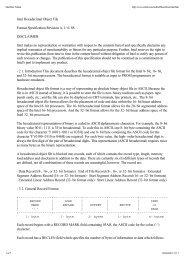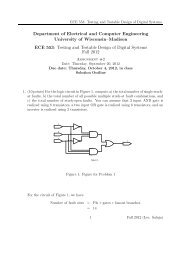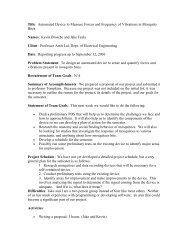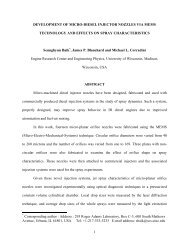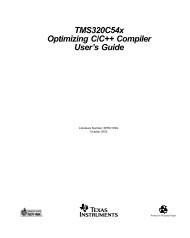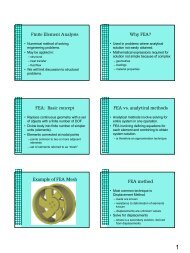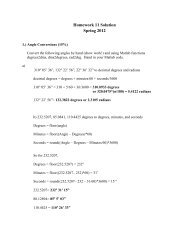Flux Coordinates and Magnetic Field Structure - University of ...
Flux Coordinates and Magnetic Field Structure - University of ...
Flux Coordinates and Magnetic Field Structure - University of ...
You also want an ePaper? Increase the reach of your titles
YUMPU automatically turns print PDFs into web optimized ePapers that Google loves.
192 11. The Dynamic Equilibrium <strong>of</strong> an Ideal Tokamak Plasma<br />
In this derivation we have used the fact that<br />
since a/aco = 0 <strong>and</strong> Vc; VY = 0 = VC; V8, all because <strong>of</strong> axisymmetry. We<br />
employed E = ~,e, = Eco VC, where Vc, = e,/~. Faraday's law is then, from<br />
(1 1.4.8) <strong>and</strong> (1 1.4.9),<br />
This means that<br />
ay<br />
- = RE, + flux function .<br />
at<br />
With Y = - Y,d,1/2n, <strong>and</strong> with ET = EkA), the net electric field, we see that the<br />
flux function can be chosen to be zero. (This follows from the integral form <strong>of</strong><br />
Amp6re's law where a C, loop is taken through point A <strong>of</strong> Fig. 11.3.) The time<br />
rate <strong>of</strong> change <strong>of</strong> the poloidal flux through a disk bounded by a fixed C, loop is<br />
thus<br />
1 % fix, = - 2nREkA) .<br />
at disk<br />
After substitution <strong>of</strong> this result in (1 1.4.6), the latter can be solved for the radial<br />
flux-surface "velocity":<br />
(In u,d, s st<strong>and</strong>s for surface <strong>and</strong> d for disk.) Taking into account that Y = - Y$,/2n,<br />
we observe from (1 1.4.4) <strong>and</strong> (1 1.4.13) that the plasma E x B inward pinch<br />
velocity is exactly equal to the radial velocity <strong>of</strong> the flux surfaces. This is a<br />
statement <strong>of</strong> the frozen flux theorem: plasma <strong>and</strong> flux surfaces are tied together.<br />
An observer sitting on (<strong>and</strong> moving with) the plasma will find that the<br />
fluid-pinch motion generates a motional EMF. The electric field connected with<br />
this motional EMF is exactly the negative <strong>of</strong> the electric field that caused the<br />
E x B inward motion in the first place. This is as it should be: an observer moving<br />
with the plasma, or thus the plasma itself, does not see any electric field. The<br />
electric field is only present in the lab frame.<br />
11.4.3 Motion <strong>of</strong> <strong>Flux</strong> Surfaces Defined by the Poloidal Ribbon <strong>Flux</strong> Ppl<br />
Suppose now that we wish to label a flux surface by the poloidal ribbon flux (see<br />
Fig. 11.3). To actually show that the flux surfaces labeled by 'Y",, = constant<br />
move with the same radially inward velocity as the plasma, we return to (1 1.4.10)<br />
or (1 1.4.1 1). When we now identify Y = Vpo1/2n, we must recognize that the<br />
11.4 Motion <strong>of</strong> the Plasma <strong>and</strong> the <strong>Flux</strong> Surfaces 193<br />
ribbon flux does not know about the transformer; all it contains is the "reaction<br />
flux" due to an increase <strong>of</strong> B,, <strong>and</strong> (Jll),. The integration constant that we called<br />
the "flux function" in (1 1.4.1 1) is the ubiquitous space independent transformer<br />
loop voltage (devided by 2n) e(t)/2n = = $E-dl/2n = Id !P/dtl/2n that<br />
we encountered in Fig. 11.1 (e(t) is spatially uniform, but E(A),tr a 1/R). Instead<br />
<strong>of</strong> (1 1.4.12), we obtain for the case <strong>of</strong> the ribbon flux:<br />
The appropriate signs can be understood from (1 1.4.12): Y = !PL,/2n <strong>and</strong> E$A'-react<br />
- ~kA),reaCt 6, A = - I ET (A),react 16,; A thus EiA).reac' is a negative quantity (see Fig. 11.3).<br />
With the flux surfaces, qo, = constant defined in a similar way to (1 1.4.5),<br />
we find for their radial "velocity"<br />
From Fig. 11.3, it is clear that EkA)." + E(A),reac'<br />
T = EkA)vtr - 1 Er).reactl = Er), where<br />
Er) is the magnitude <strong>of</strong> the net toroidal electric field (EkA) > 0). Thus<br />
A comparison with (1 1.4.4) <strong>and</strong> (1 1.4.13) shows that, indeed,<br />
Thus plasma <strong>and</strong> flux surfaces labeled by a constant poloidal (ribbon or disk)<br />
flux move together.<br />
11.4.4 Motion <strong>of</strong> <strong>Flux</strong> Surfaces Defined by the Toroidal <strong>Flux</strong> Yt0,<br />
Finally, we show that the toroidal-flux label Ytor leads to a similar conclusion.<br />
We could invoke the general applicability <strong>of</strong> the frozen-flux theorem: the plasma<br />
<strong>and</strong> the flux surfaces (regardless <strong>of</strong> their label) move together. Simple manipula-<br />
tions with formulae, however, provide some physical insight: the toroidal-flux<br />
change should be connected with the poloidal electric field.<br />
To find the inward E x B plasma velocity, we first derive a geometric<br />
relationship for the component perpendicular to B in terms <strong>of</strong> poloidal <strong>and</strong><br />
toroidal components. From (1 1.2.2) we obtain:<br />
The only induced E-field component present is in the perpendicular direction




